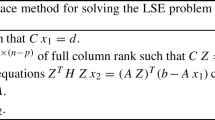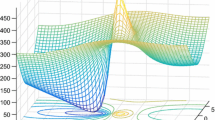Abstract
We present algorithms for solving quadratically constrained linear least squares problems that do not necessarily require expensive dense matrix factorizations. Instead, only “black box” solvers for certain related unconstrained least squares problems, as well as the solution of two related linear systems involving the coefficient matrixA and the constraint matrixB, are required. Special structures in the problem can thus be exploited in these solvers, and iterative as well as direct solvers can be used. Our approach is to solve for the Lagrange multiplier as the root of an implicitly-defined secular equation. We use both a linear and a rational (Hebden) local model and a Newton and secant method. We also derive a formula for estimating the Lagrange multiplier which depends on the amount the unconstrained solution violates the constraint and an estimate of the smallest generalized singular value ofA andB. The Lagrange multiplier estimate can be used as a good initial guess for solving the secular equation. We also show conditions under which this estimate is guaranteed to be an acceptable solution without further refinement. Numerical results comparing the different algorithms are presented.
Similar content being viewed by others
References
Å. Björck.Least squares methods. In P. G. Ciarlet and J. L. Lions, editors,Handbook Of Numerical Analysis, Vol. II. Finite Difference Methods-Solution of Equations in R n. Elsevier/North Holland, 1988.
L. Eldén.Algorithms for the regularization of ill-conditioned least squares problems. BIT, 17:134–145, 1977.
G. E. Forsythe and G. H. Golub.On the stationary values of a second-degree polynomial on the unit sphere. J. Soc. Indust. Appl. Mathematics, 13(4):1050–1068, 1965.
W. Gander.Least squares with a quadratic constraint. Numer. Math. 36:291–307, 1981.
W. Gander, G. H. Golub, and U. Von Matt.A constrained eigenvalue problem. Linear Algebra Appl, 114/115:815–839, 1989.
G. H. Golub and C. F. Van Loan.Matrix Computations. The Johns Hopkins University Press, Baltimore, Maryland, second edition, 1989.
M. D. Hebden.An algorithm for minimization using exact second derivatives. Technical Report T.P. 515, Atomic Energy Research Establishment, Harwell, England, 1973.
C. H. Reinsch.Smoothing by spline functions ii. Numer. Math., 16:451–454, 1971.
Author information
Authors and Affiliations
Additional information
Research supported by SRI International and by the National Science Foundation under grants DMS-87-14612 and ASC 9003002.
Rights and permissions
About this article
Cite this article
Chan, T.F., Olkin, J.A. & Cooley, D.W. Solving quadratically constrained least squares using black box solvers. BIT 32, 481–494 (1992). https://doi.org/10.1007/BF02074882
Received:
Revised:
Issue Date:
DOI: https://doi.org/10.1007/BF02074882




